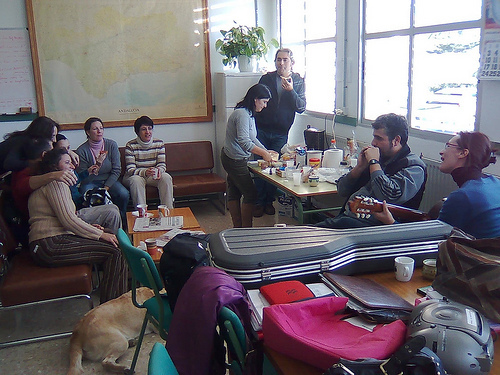Ryan Noel just wanted his fellow teachers to see him receive money for his classroom. But teachers union officials in Valley Heights, Kansas barred him from receiving the award at school, because it came from Noel’s new, nonunion professional organization, the Kansas Association of American Educators (KANAAE).
“Here’s someone giving to education to help students, yet the strong arm of the union was really not willing to allow that to happen,” said Noel.
This February, more than a year after the incident, Noel testified in favor of House Bill 2221, legislation that would guarantee Kansas union and nonunion membership organizations equal access to school mailboxes, bulletin boards, e-mail systems, and meetings. Currently, unions get priority and can muscle out competitors.
Professional teacher associations that offer teachers liability insurance, professional development scholarships, and networking have begun cropping up around the United States. They do not conduct collective bargaining, so they are not unions, and they cost considerably less. Membership in the Association of American Educators costs $180 a year, while union membership is often $600 or more annually. AAE also refrains from non-education political activism.
Principals in the Middle
On February 14, Kansas’ House Education Committee approved HB 2221. It closely resembles a 2007 Utah equal access law.
KANAEE executive director Garry Sigle said incidents like Noel’s are fairly commonplace in Kansas. Schools have shooed him from campuses during the school day, while routinely welcoming his union counterparts.
“I’ve had appointments that were set up and scheduled,” Sigle said. “Then the union threw a fit, and the administrator had to cancel because of the pressure the union put on them.”
The Kansas National Education Association (KNEA), which has exclusive bargaining rights over most of the state’s teachers, opposes HB 2221. They argue local school boards should make decisions on equal access.
But Sigle said principals and superintendents are often caught between a powerful union and his nonunion group, and seek to avoid controversy. “The change in the law will take [administrators] out of the middle,” he said.
Trashing Brochures
In August 2012, Tamara Krumm, a special education teacher, placed a KANAAE brochure on the Jefferson Elementary teachers lounge bulletin board. The school principal, citing the negotiated bargaining agreement, complied with the union’s request to remove the brochure.
“The state union told local union people to pick it up and throw it in the trash,” Sigle said. “That doesn’t seem like a local issue.”
Many public school teachers are not aware they have nonunion options. Claudia Boyles, a high school science instructor in western Kansas, first learned of KANAAE when she met Sigle through a mutual friend at a triathlon in fall 2012.
About the same time, she received a union mailer urging her to vote for political candidates she did not support. “That was the straw that broke the camel’s back,” Boyles said. She dropped her KNEA membership after 10 years.
Boyles and a third of her colleagues at Holcomb High School since have become KANAAE members. Some don’t belong to any organization; Kansas teachers are not required to join or fund unions.
Leveling the Playing Field
HB 2221 is not the Kansas legislature’s first stab at leveling the field for teacher organizations. In 2011 the House passed a similar measure, but it failed to gain a sponsor in the Senate. Sigle notes this year’s legislation won more committee votes than its predecessor and the Senate is “more conservative.”
In legislative testimony, Kansas Policy Institute spokesman James Franko compared HB 2221 to 1900s “trust-busting” that broke business monopolies. The bill “offers a freedom to teachers that is currently hard for them to realize,” he said.
Noel says the proposal would provide long-overdue commonsense changes. “Part of me feels like we’re living in the Stone Age when only certain groups can be in schools,” the elementary teacher said. “My hope is that legislators would allow AAE into our schools, too, so teachers can have a choice.”
Learn more:
“New Report Reveals Teachers Unions Bully Teachers and Competitors,” School Reform News, April 2012: http://news.heartland.org/newspaper-article/2012/04/27/new-report-reveals-teachers-unions-bully-teachers-and-competitors.
Image by ryangs.




